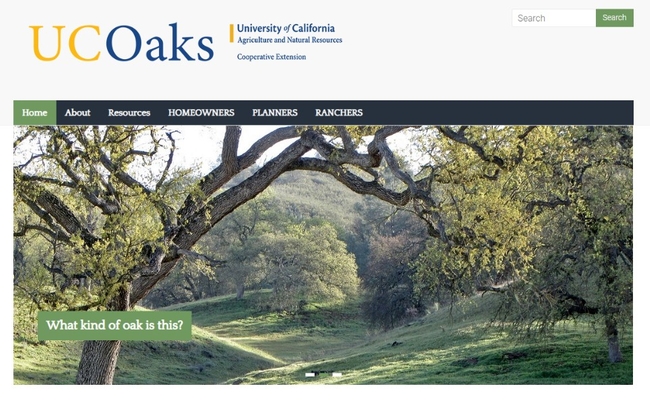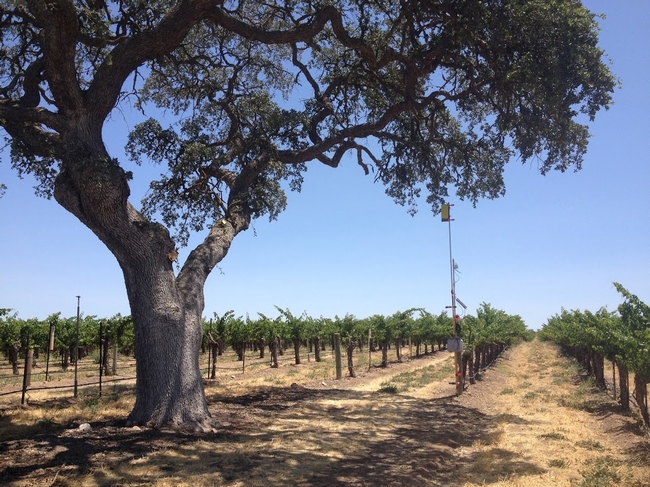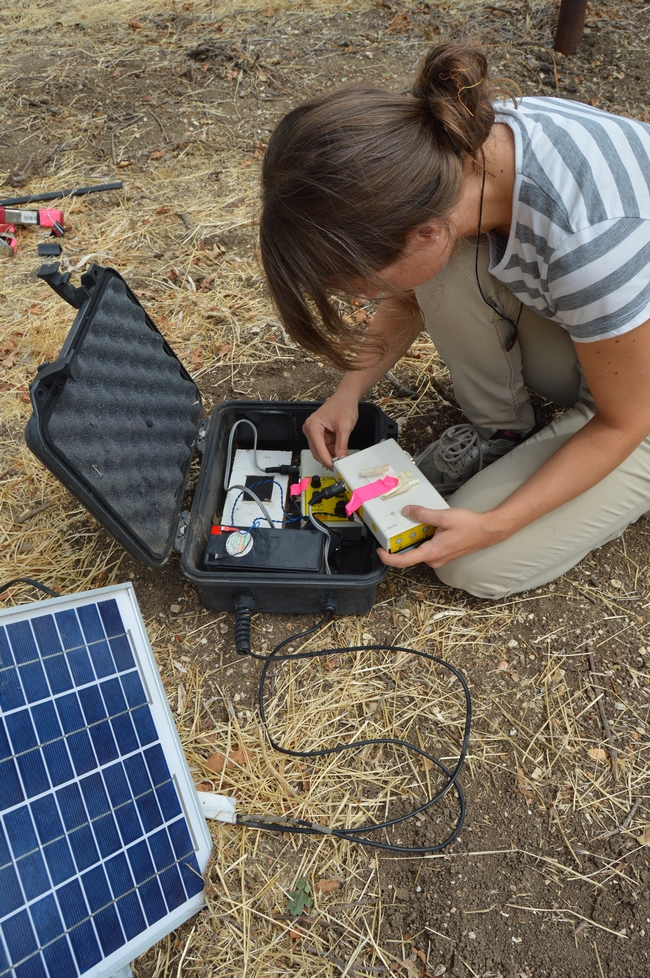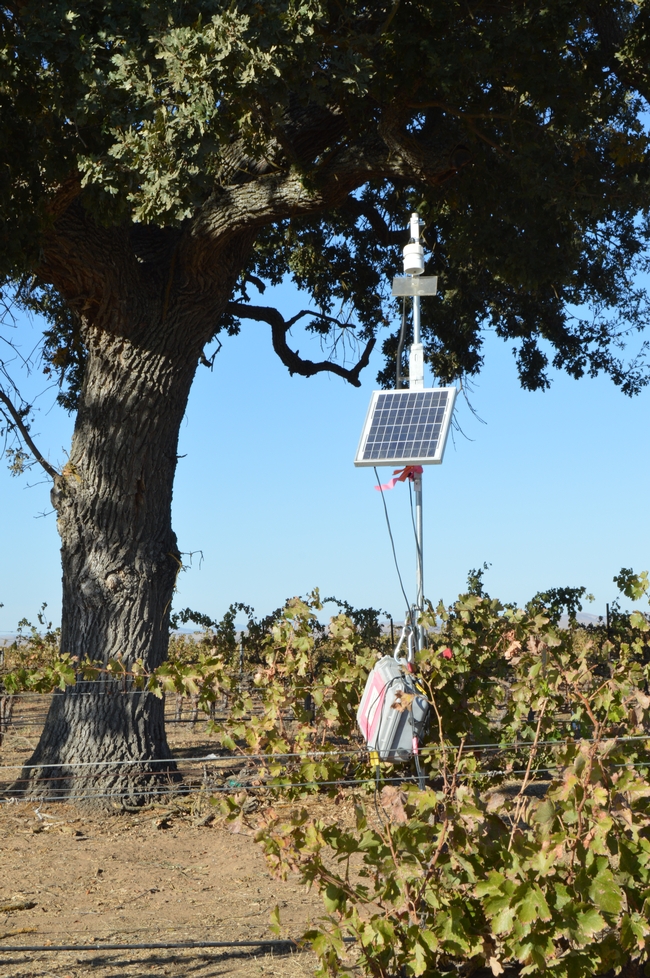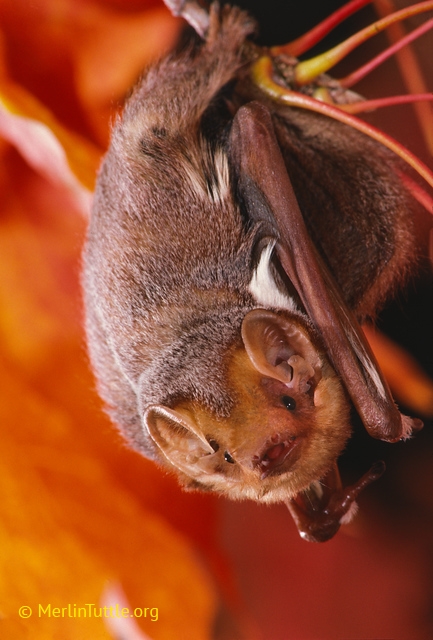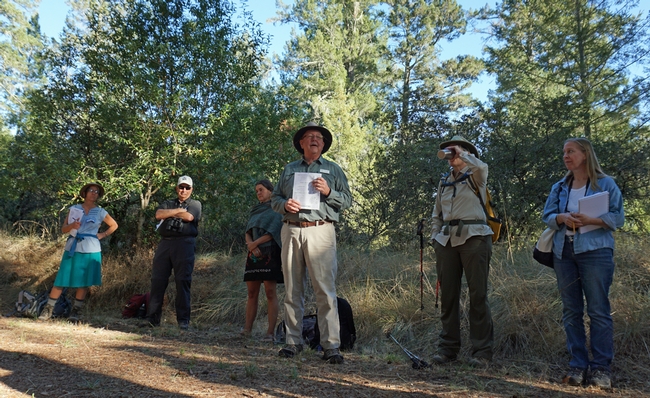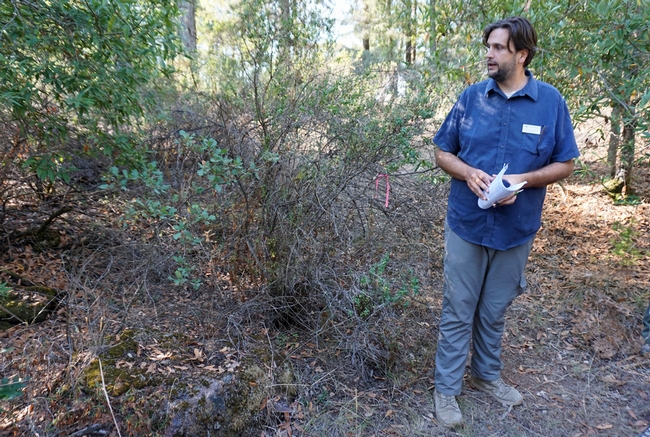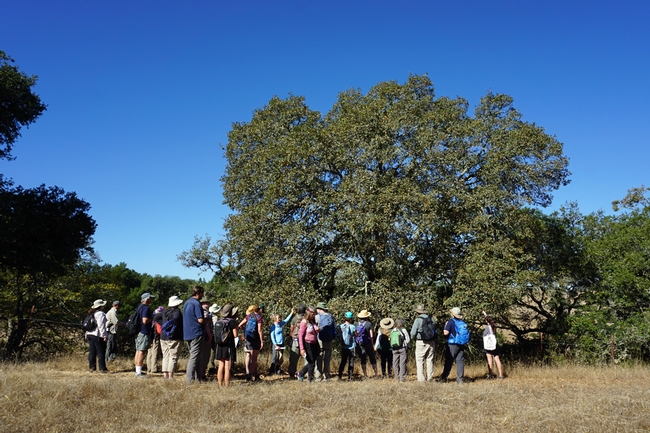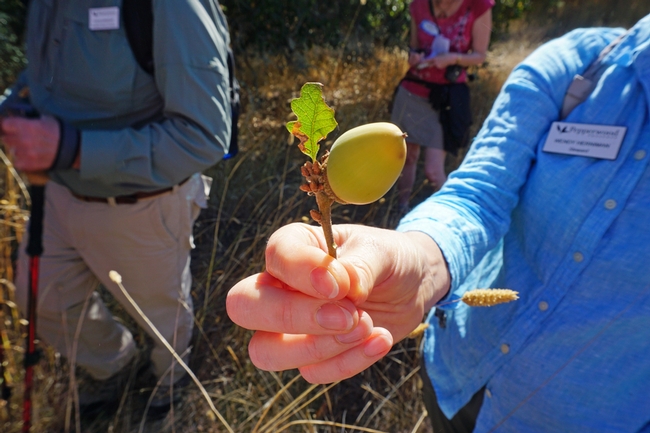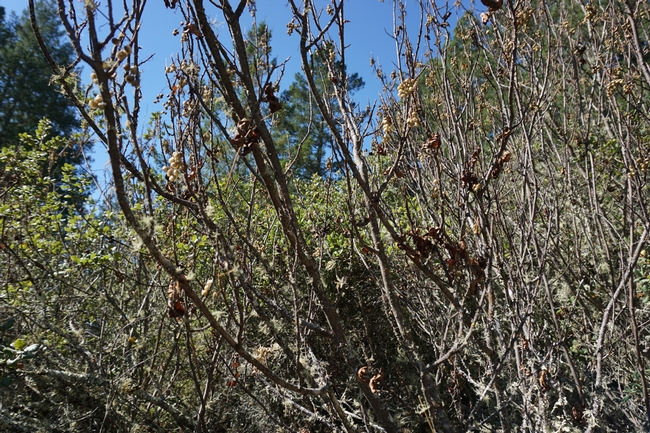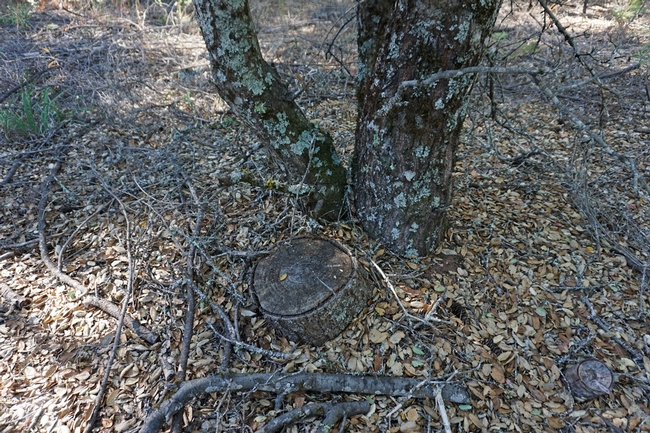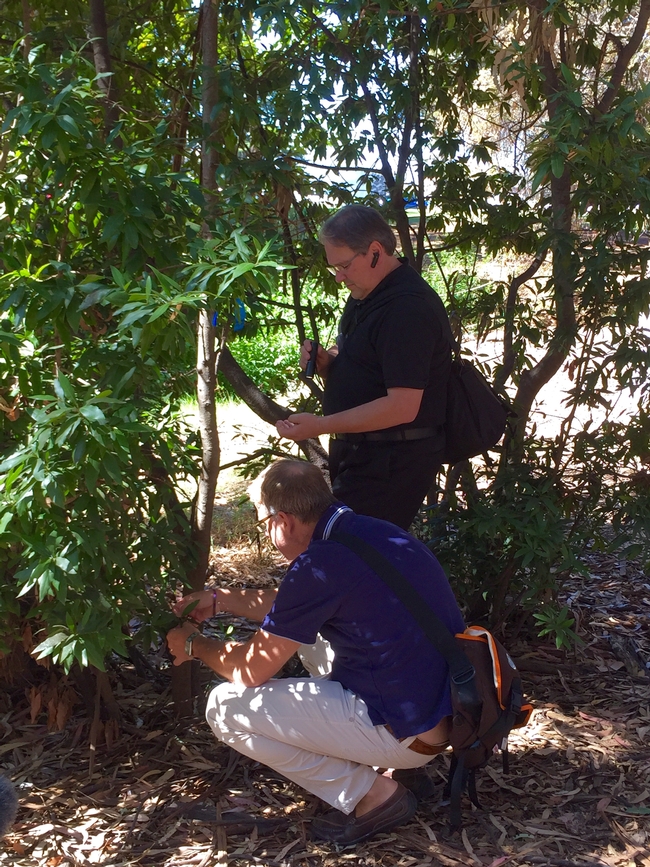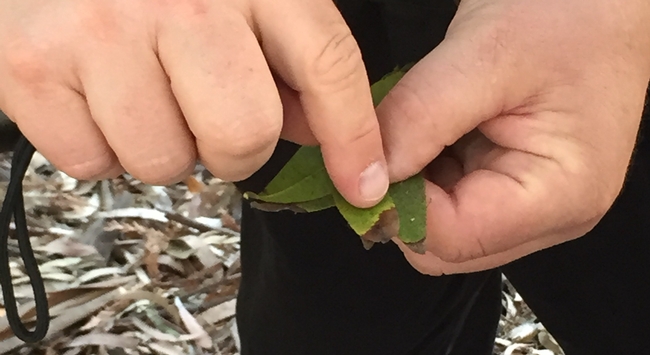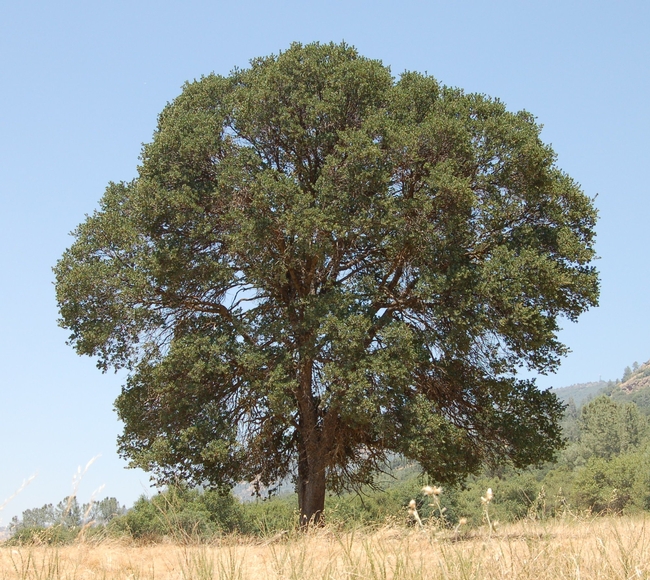Posts Tagged: oaks
Curious about oaks? Find answers on new UC Oaks website
Oak trees are iconic in California's landscape. Just about anything you would like to know about caring for the state's 8 million acres of oak woodlands is now accessible to the public online. University of California Cooperative Extension scientists have updated the UC Oaks website at https://oaks.cnr.berkeley.edu with oak ecology, management and oak woodland conservation information based on over 30 years of research.
“On the home page, we have highlighted oak topics – such as oak planting, oak ecology and rangeland management – that have been of special interest to website users,” said Bill Tietje, UC Cooperative Extension natural resources specialist at UC Berkeley, based in San Luis Obispo.
About 80% of the oak woodlands in California are privately owned, with the majority used for grazing, primarily by beef cattle.
“We added some of the latest UC oak research and plan to promote the website to groups who have not historically used it, in particular, the ranching community,” said Devii Rao, UC Cooperative Extension livestock and natural resources advisor for San Benito, Monterey and Santa Cruz counties. “It is essential that landowners and managers have the tools they need to maintain healthy trees and conserve large-scale oak woodlands.”
Development policy, livestock management on rangelands, urban oak care, oak regeneration, effects of wildfire on oaks, wildlife and threats to oak woodlands are featured on the website.
Since its creation in 1995 by emeritus UC Cooperative Extension specialist Rick Standiford, the website, originally called UC Oak Woodland Management, has been a valuable educational resource, with an average of 45,000 visitors annually.
Updating and redesigning the website for mobile devices was funded by a Renewable Resources Extension Act Capacity Grant received by Tietje, Rao and Luke Macaulay, UC Cooperative Extension specialist rangeland planning and policy specialist at UC Berkeley. They worked with a professional designer to improve the website's functionality and visual appeal, and will continue to add new information.
To increase user friendliness, the UCCE team created links at the top of the UC Oaks home page for its three primary target audiences: homeowners, land-use planners and ranchers.
If you can't find an answer, click the “Ask an Oak Expert” button to submit your question and a UCCE oak expert will reply.
“With its new look and expanded reach, we hope that the website will be a one-stop shop for everything people need to know about oak woodland conservation and management,” said Rao, who manages the website.
Oaks in vineyards a ‘win-win’ for bats and growers
Californians love their oak trees. During vineyard development, Central Coast grape growers often feel compelled to leave an old iconic oak standing, even if it ends up right in the middle of their vineyard. While driving through the Central Coast, it's not unusual to see the pattern of vineyard rows broken by a majestic oak tree. Aside from their beauty, what are some of the ecosystem services that these majestic trees provide?
To find answers, a UC Cooperative Extension scientist in San Luis Obispo County collaborated with a U.S. Forest Service scientist to study how bats use blue oak and valley oak trees in vineyards. UC Cooperative Extension specialist Bill Tietje, a co-author of the study, says they focused on bats that eat insects because bat populations have declined dramatically in some areas due to habitat loss and disease. “And bats don't hurt grapes. As a matter of fact, thanks to the huge number of bugs they consume—bats could be very good for a vineyard.”
To understand the potential value of remnant oak trees for insectivorous bats, the researchers placed microphones to detect bat calls within 14 Central Coast vineyards. The recordings revealed 11 species of insectivorous bats foraged within the vineyards and bat foraging activity was 1.5 times greater at the trees compared to open, tree-less areas within the vineyard. And the bigger the tree, the bigger the number of bats it attracted.
“The study results suggest that the large oak tree in my vineyard not only increases the beauty and biodiversity of the agricultural landscape, but also attracts insect-eating bats that can provide natural pest control—a win-win,” said grape grower Jerry Reaugh, who cooperated with the researchers.
In fact, the presence of insectivorous bats called woodland-adapted bats more than doubled within the vineyards with trees. The study indicates that the oak trees attracted woodland-adapted bats that would normally be absent from vineyards.
Tietje hopes that the free insect-reduction services provided by bats will increase grape growers' incentive to manage and maintain the trees, and even to plant new oak trees in suitable areas around their vineyard, in mutual benefit to both agriculture and biodiversity.
“In addition to their value for insectivorous bats, remnant trees maintain bird and insect diversity by providing food, habitat, cover and stepping stones that facilitate the movement of wildlife within agricultural landscapes,” said Tietje.
This study comes at a time when declining blue oak and valley oak populations are of great concern.
“We hope the study will increase awareness of these beautiful and beneficial trees and make the case for conservation and restoration,” Tietje said. “Preserving and enhancing biodiversity in the midst of climate change is key to ensuring resilience in our landscapes and communities.”
Hybrid oak trees muddle identification at California Naturalist Regional Rendezvous
Knowing the names of trees is a point of pride for many California Naturalists. So a walk among the diversity of oaks at the Pepperwood Preserve left many feeling humbled.
The three-hour excursion was part of the UC California Naturalist Regional Rendezvous in October at the 3,200-acre nature preserve nestled in the foothills between Napa Valley and Santa Rosa.
Excursion leader Steve Barnhart, academic director emeritus at Pepperwood, said there are 500 oak species in the world; 21 in California. But cohabitating on the rolling hills and valleys of the Golden State, many oaks have produced hybrids that combine characteristics, making identification challenging.
Doctoral candidate Phrahlada Papper, who is studying oak tree genetics, said, “I'm of the mind that you shouldn't ever name an oak.”
Even the tan oak, long thought to be misnamed, is coming under new scrutiny.
“It's not an oak,” Barnhart said. “It has acorns, male and female flowers on the same stalk, but tan oaks are insect pollinated. True oaks are wind pollinated. Tan oaks are closer to chestnuts.”
But Papper raised his hand. “Genetically, it might be an oak,” he said.
Barnhart laughed. “So tan oak is up in the air. That's why it's so much fun to be in science,” he said. “I learned something today.”
In popular culture, oaks are thought to be majestic, towering trees, with wide spreading branches. However, Barnhart said, most California oaks are shrubs, including the leather oak.
Leather oaks grow in serpentine soils and have the ability to produce two types of flowers, one in the spring and another quite different in the fall. Leather oaks are monoecious, they have both male and female flowers on the same plant. On a particular leather oak at Pepperwood, Papper was surprised to find male and female flower parts in one bract and surmised that weather patterns may be responsible.
“California has weird weather and with climate change, it's getting even more weird,” Papper said.
Papper believes tracking phenology, the cyclic and seasonal changes in plants, is an ideal citizen science project for California Naturalists. One such project underway at Pepperwood is led by Wendy Herniman. A University of Edinburgh, Scotland, master's student, Heniman is documenting the phenology of 10 Pepperwood oak trees: 2 blue oaks, 3 coast live oaks, 2 black oaks and 3 Oregon oaks.
“Pepperwood is looking at climate change. It's a designated sentinel site. We're monitoring fog, we have soil probes, and we're collecting all weather and climate information. We can tie that to phenology,” she said. “We're trying to find out if phenophases are changing.”
Understanding the changing phenophases is important, Barnhart said.
“Everything is connected,” he said. “If acorns are produced early, animals species that depend on the food source will be disrupted. You have imbalances in the timing of the natural world. With climate change, what are the effects we'll be seeing?”
Sudden oak death moving to urban areas; 3 steps to protect oaks
Drought is decreasing but not defeating the pathogen that causes sudden oak death, according to a citizen science-assisted survey conducted this spring by a UC Agriculture and Natural Resources forest pathologist.
Results of the 2015 Sudden Oak Death Blitz survey reveal coastal mountain infestations in areas such as Big Sur (19% infection), the Santa Cruz Mountains (13% infection), and western Sonoma County (12% infection) remain high despite an overall decline in infection rates from 4.4% to 3.7% across California's 15 infested counties.
Sudden oak death (SOD) symptoms have been seen in Alameda, Contra Costa, Humboldt, Lake, Marin, Mendocino, Monterey, Napa, San Francisco, San Mateo, Santa Clara, Santa Cruz, Solano, Sonoma and Trinity counties.
“Understanding the current disease distribution is key to preventing sudden oak death spread. Citizen scientists have been an invaluable help with this task over the last decade,” said Matteo Garbelotto, UC ANR Cooperative Extension specialist in the Department of Environmental Science, Policy and Management at UC Berkeley, who organizes the annual SOD Blitz.
Several new SOD outbreaks of note were identified during the blitzes. Two infected California bay laurel trees were confirmed near UC Berkeley's West Gate, a high-traffic, high-risk area with many heritage oaks. An infected California lilac shrub was found in the Presidio of San Francisco's (part of the Golden Gate National Recreation Area) southeastern quadrant. An infected California bay laurel tree was confirmed in Danville (eastern Contra Costa County) in an area where SOD had not previously been reported, and an urban park in Saratoga was found infested for the first time.
“In an effort to protect habitat restoration in the Presidio, we are working to strengthen Best Management Practices to prevent the spread of SOD based on the Garbelotto lab recommendations,” said Christa Conforti, integrated pest management specialist at Presidio Trust in San Francisco. “In partnership with UC, the National Park Service, and the Golden Gate National Parks Conservancy, we are developing a Phytophthora prevention, detection and control strategy, which includes active participation in SOD Blitzes.”
Nineteen citizen science-based SOD Blitzes (largest number of blitzes to date) were held this spring, two of which were new this year – one in Trinity County and one on Kashia Band of Pomo Indian land in Mendocino County. The 504 volunteers surveyed nearly 10,000 trees from San Luis Obispo County, north to Mendocino and Trinity counties. Each volunteer was trained to identify Phytophthora ramorum (the plant pathogen known to cause SOD) symptoms on California bay laurel and tanoak leaves. “Blitzers” had up to three days to collect and record locations of symptomatic samples, which were then sent to the Garbelotto lab for DNA analysis to determine the presence or absence of the pathogen.
SOD management workshops
Garbelotto is sharing results from the spring blitzes as well as new recommendations for SOD management at workshops being held around the Bay Area. Workshops will be held in Sebastopol on Nov. 3, in Berkeley on Nov. 4, and in San Rafael on Nov. 13. For details, see “Community meetings” at sodblitz.org.
For landowners in infested areas concerned about protecting their oak trees, Garbelotto will reveal his updated three-step SOD management plan. He will show them how to:
- Use the SODMap mobile app to help assess risk of oak infection (see sodmapmobile.org).
- Determine if California bay laurel trees near high-value oaks should be considered for removal (using a new buffer zone new chart - http://nature.berkeley.edu/garbelottowp/?page_id=2345).
- Apply phosphonates to high-value oak and tanoak trees to boost immunity (updated dosages and application frequencies at http://nature.berkeley.edu/garbelottowp/?page_id=2348).
Infection on California bay laurel and tanoak leaves indicates arrival of P. ramorum to an area, but true oak (California black oak, coast live oak, canyon live oak and Shreve's oak) infection typically requires a couple of years with wet conditions after pathogen arrival. Therefore, preventatively treating oaks to help ward off infection is best done when early indicator species first show symptoms, prior to oak infection and optimal conditions for the pathogen – cool and moist.
These surveys are made possible thanks to funding from the USDA Forest Service and the PG&E Foundation as well as help from the California Native Plant Society.
For more information on the workshops, go to sodblitz.org or contact Katie Harrell at (510) 847-5482 or kpalmieri@berkeley.edu. For more information on sudden oak death and P. ramorum, visit the California Oak Mortality Task Force website at suddenoakdeath.org.
Give oaks water once a month
Even though California's majestic oak trees are generally considered drought tolerant, the last four years of well-below-average rainfall are taking a toll, reported the Sierra Sun Times.
"In some parts of the state, oaks are being deprived of water for as long as nine months, creating extreme water stress," said Greg Giusti, a forest and wildlands advisor for UC Agriculture and Natural Resources. Giusti is headquartered in the UC ANR Cooperative Extension office in Mendocino County.
Giusti and Kris Randal, the UC Master Gardener coordinator for Mariposa County, suggest that California residents with oaks on their property give the trees a good soaking once a month during the summer.
The water should be applied around the drip line - the area below the outstretched branches - but not near the trunk. A permeable soaker hose is an ideal tool for slow application over the wide area. Allow the water to run until it has soaked down to a depth of 12 to 18 inches, which can be detected with a long probe such as a screwdriver. "If it comes up with signs of moisture at the tip, you're good," the article says.
Randal said it is important to let the soil dry out completely between waterings, because oaks are susceptible to root fungus that can grow in warm, damp soil.
Even if water is unavailable and the leaves begin to turn brown or fall, the experts suggest waiting for spring before considering removing the tree.
"If you tree leafs out, it's still alive," Randall said. "And in this drought, give it extra time to leaf out."


